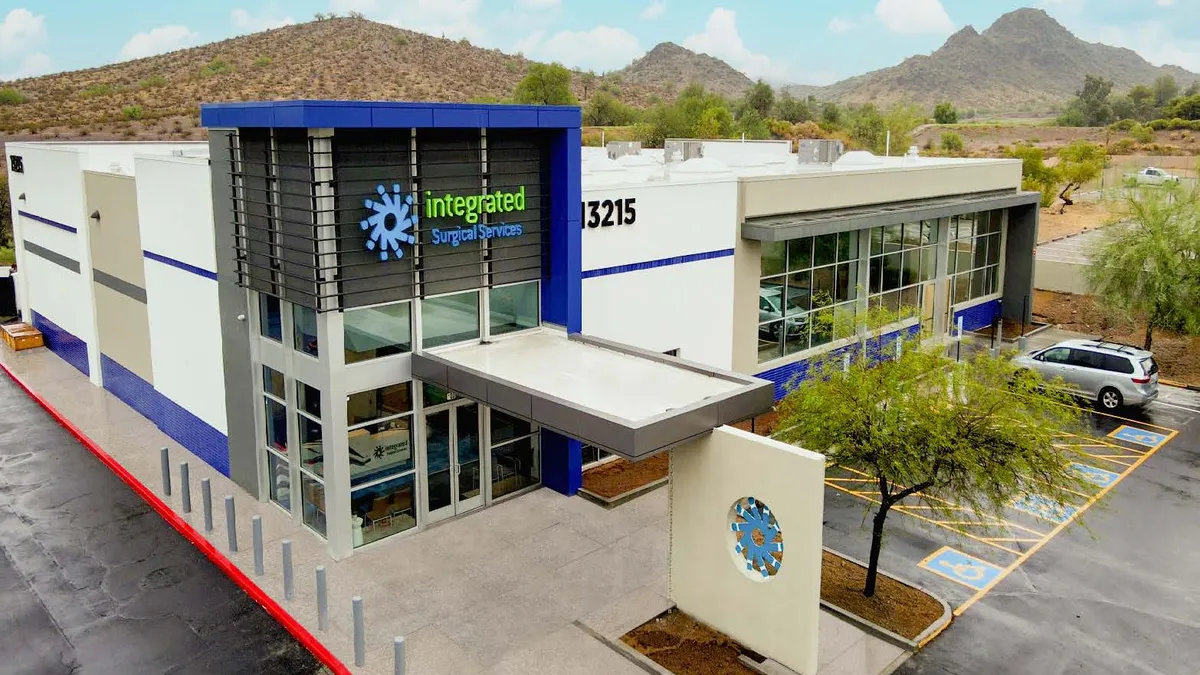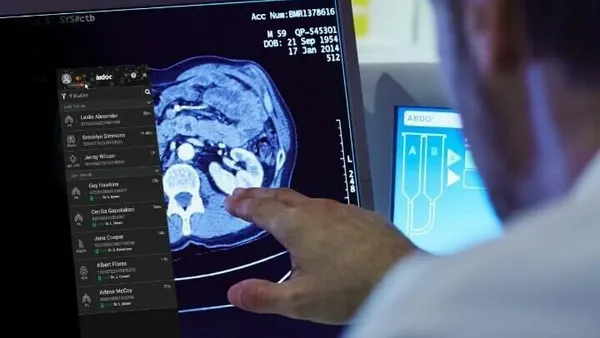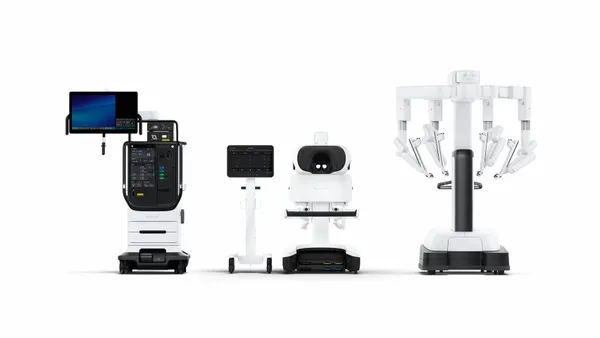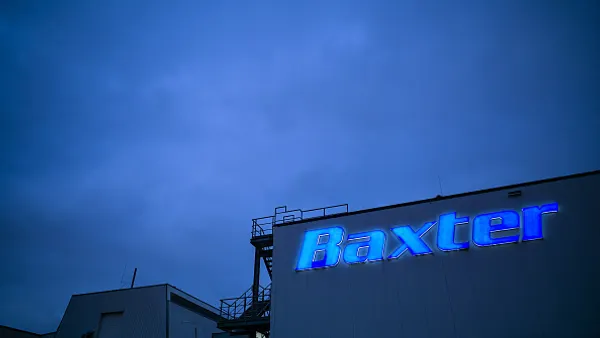A year ago, Dr. Brian Gruber opened Integrated Surgical Services in Phoenix, transforming a former grocery store into an ambulatory surgical center (ASC) for outpatient orthopedic surgeries.
“The genesis of the whole thing was the ability to control patient experience,” Gruber said. “Hospitals are our friends, but there's only so far your voice can go at some of the bigger facilities.”
Physicians say ASCs give them the ability to better control expenses and the patient experience, while keeping costs lower than they would be in a hospital. By owning the equipment and focusing on one specialty, it’s easier to schedule procedures and run an operating room more efficiently, and they add, professionally more fulfilling.
“The flexibility of having your own space, your own ASC, from a surgical standpoint, it's awesome. We really like to be able to just do stuff,” Gruber said. “You don't have to go through a zillion people, all the red tape. You just do it. And if you need to cut somebody a deal financially, you do it. Just to have that ability and the power to do that, it’s liberating, really.”
Gruber is one of hundreds of physicians who have opened an ASC in the last decade. Across the U.S., there are now more than 6,000 ASCs, up from more than 5,000 in 2010, according to the ASC Association, a lobbying group for the facilities. Orthopedic procedures in particular have shifted to outpatient centers, driven in part by the pandemic and also by Medicare’s increased willingness to pay procedures performed at ASCs. Total knee replacements were added in 2020, and total hip replacements in 2021.
Seeing an opportunity, medical device companies are increasingly catering to ASCs, with financing plans for equipment and even teams to help construct and design surgical centers. For larger, pricier devices, such as surgical robots, more companies have started offering per-procedure prices, leases, and payment plans.
While many hospitals have well-established budgets for purchasing capital equipment, ASCs may look for more flexible financing options, Zimmer Biomet Chief Operating Officer Ivan Tornos wrote in an email.
“Many look for cashless options to obtain capital equipment and services along with implant and disposable purchases to offset extensive costs required for future new builds, resulting in improved operational cash flow/preserved lines of credit as they ramp procedures,” Tornos said.
Medicare payments to ASCs increased until the pandemic
Manufacturers of orthopedic devices expect the number of procedures done in ASCs to rise, but that doesn’t mean the total number of surgeries is increasing — they’re just moving to a different setting, said Shagun Singh, an analyst with RBC Capital Markets.
“It remains to be seen if it would allow more people into the funnel,” Signh wrote in an email. “[Reconstruction] is a mature market, growing 3-4% in a normalized environment. There may be less room for market expansion vs. in other under-penetrated medical device sub-markets.”
Still, the switch has prompted medical device companies to build dedicated teams to work with ASCs.
Johnson & Johnson subsidiary DePuy Synthes, which estimates that 21% of orthopedic procedures are being done in ASCs, has an ASC team to offer custom solutions to surgeon-entrepreneurs and ASC administrators, said Andrie Leday III, the company’s U.S. commercial vice president of ambulatory surgery centers. DePuy’s assistance includes capital programs for buying equipment and help with coding and insurance reimbursement.
“While this trend was well underway for both clinical and economic reasons, COVID-19 helped to accelerate this shift,” Leday wrote in an email.
Stryker, the largest orthopedics company by revenue, estimates that 10% of joint replacements are being done in ASCs and expects that number to double in the next five years.
Hundreds of ASCs are being built every year, Chad Evans, Stryker’s general manager of ASC and neurotechnology sales, wrote in an email. The company can help with the initial planning, design and construction of new ASCs — from the waiting room furniture to implants, stretchers and other pieces of equipment.
While competitors like J&J and Smith & Nephew have dedicated teams working with ASCs, Stryker is “over indexed” in that market compared to its peers, according to Singh.
“They are actually years ahead of a lot of folks because they actually have architects,” she said. “They can have an architect, they'll build out a whole OR for you, the whole ASC setup. And then they're going to sell you everything.”
Knee and hip replacements are the fastest-growing orthopedic procedures for ASCs
Proponents of ASCs say they can perform surgeries at a lower cost with similar outcomes because they don’t have to cover the overhead costs of running a hospital. According to the ASC Association, Medicare pays ASCs 55% of the amount it pays a hospital for the same outpatient surgical procedure. For a total knee replacement, Medicare will pay an ASC $8,222, compared with $12,088 to a hospital outpatient department, according to Medicare’s price lookup tool. Still, patients pay more for the surgery at ASCs because for high-cost procedures, Medicare caps co-pays at hospital outpatient departments but not at ASCs.
In 2021, ASCs performed 16.5% of knee replacements and 12.1% of hip replacements in the U.S., according to data from Definitive Healthcare, a healthcare data firm. While Medicare now covers the two procedures at ASCs, the group has been lobbying the Centers for Medicare and Medicaid Services to add shoulder and ankle reconstruction as well as lumbar spine fusion in surgery centers.
Despite the difference in reimbursement, ASCs often spend the same amount for implants and devices as hospitals, the ASC Association wrote in a Sept. 13 letter to the CMS. In fact, hospitals are more likely to buy in bulk through larger purchasing agreements and be offered lower prices. To offset the costs, physician owners seek funding or look to strike deals with device companies.
Hospital outpatient departments still lead in most orthopedic procedures
Partnerships to procure equipment
Gruber worked with Stryker when he built his ASC. Through a joint venture with the company, which provided capital in exchange for a promise of spending over a five-year period, he was able to procure some of the bigger equipment for the facility, such as the Mako surgical robot used for joint replacement surgery. Other large equipment, such as ultrasounds and C-arms, are typically financed.
While some physicians may choose to mix and match equipment, Gruber chose to purchase all of his from Stryker, he said.
“For me, Stryker holds the biggest service lines. They have got so much equipment,” Gruber added. “It was the ‘easy button’ to partner with Stryker in that regard.”
In many cases, physicians band together and seek financing from private equity firms to help cover the cost of opening a new facility. They can also seek joint ventures with hospital groups, like Tenet, which has spent billions to build out its ambulatory surgery unit.
New Mexico Surgery Center Orthopaedics, an Albuquerque-based ASC, opened in 2000 through a partnership between physician group New Mexico Orthopaedics and Ortholink, which helped with financing and had a management contract. Now, a local hospital also holds a minority stake in the facility, although the physician group still has the largest share, said Dr. Bill Ritchie, an orthopedic surgeon with the group.
The ASC has favored Zimmer Biomet products because of its focus on total joints, Ritchie said. Otherwise, it procures products from a mix of vendors, seeking volume discounts for items including lighting, cameras, power systems and disposable items such as drill bits. For surgical robots, the company went with “one manufacturer that we do the most business with,” and the contract is written as a lease where the cost is brought down by increasing volume.

Bartering with scale
Volume purchases are key to the success of larger groups that operate hundreds of ASC facilities. At Surgical Care Affiliates (SCA Health), a 320-facility outpatient surgery company owned by Eden Prairie, Minn.-based insurer Optum, the number of joint replacements performed each year has almost doubled from 2019 to 2022, said Amanda Conroy, who leads the company’s total joint replacement and spine service lines.
That lets SCA set the prices it pays device vendors for total joint replacements.
“This was the first time in our company’s history that we’ve been able to collectively do that. It’s generated millions of dollars of savings for our patients,” Conroy said. Lower costs also benefit the insurance company that owns SCA.
Without the capital that a hospital can muster, SCA has used what Conroy calls “creative solutions” to obtain expensive equipment, including surgical robots, specialty operating tables and imaging equipment. It decides on a case-by-case basis whether it's more cost-effective to purchase equipment or lease it.
Partnering with equipment vendors is key, said Brandon Hollis, regional vice president of musculoskeletal operations for Amsurg, which has more than 250 ASCs across the U.S.
“A capital purchase would be a much more simple process for a hospital system whereas now in the ASC industry, what we see with a lot of the larger, more expensive pieces of equipment, including robots, x-rays and microscopes… the vendors have done a really good job of offering different types of payments plans,” he said.
What it means for device companies
The shift from purchasing expensive equipment outright to renting or financing has shown up in device makers’ quarterly earnings.
Both Stryker and Zimmer Biomet, which is the third largest in orthopedics, said the shift has resulted in less upfront revenue from their surgical robots, which help surgeons with knee and hip implant placement.
Stryker reported that sales of its Mako surgical robots climbed 19% in the second quarter of 2022 compared with the year-earlier period, although the deal mix resulted in less revenue per quarter. The company also said the ratio of sales of its Mako robots at ASCs versus hospitals gradually has been increasing.
“This has been happening over the past kind of six months where we are seeing more deals being financed versus outright purchased, and actually a move towards more rental agreements,” CEO Kevin Lobo said in an Aug. 2 earnings call.
For its part, Zimmer Biomet has said about 30% of installations of its ROSA robots have been in ASCs.
Although the amount medical device companies currently get is the same no matter the setting, that could change in the future, according to RBC Capital’s Singh.
“The ASC is a lower cost setting and reimbursement is also lower. So at some point, I do expect some pricing headwinds for the ASC setting, which may impact our medical device companies, but we have not seen it yet,” Singh said.














